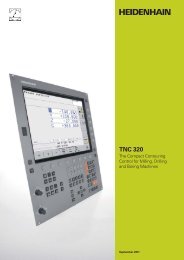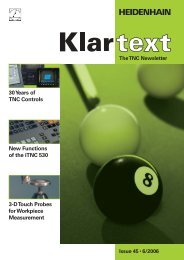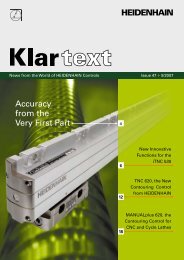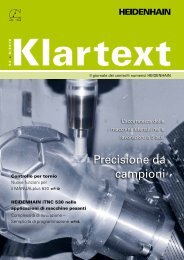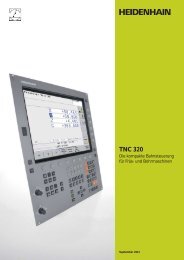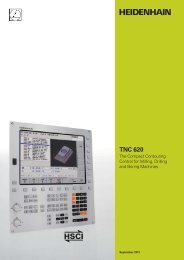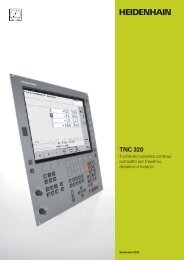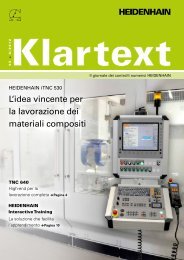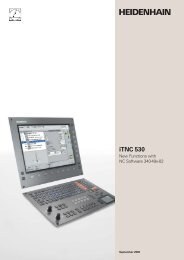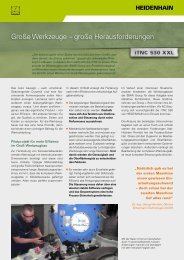iTNC 530 - TNC 640 - DR. JOHANNES HEIDENHAIN GmbH
iTNC 530 - TNC 640 - DR. JOHANNES HEIDENHAIN GmbH
iTNC 530 - TNC 640 - DR. JOHANNES HEIDENHAIN GmbH
Create successful ePaper yourself
Turn your PDF publications into a flip-book with our unique Google optimized e-Paper software.
Workpiece presetting<br />
You can use a reference point to assign a<br />
defi ned value in the <strong>i<strong>TNC</strong></strong> display to any<br />
workpiece position. Finding this point<br />
quickly and reliably reduces nonproductive<br />
time and increases machining accuracy.<br />
The <strong>i<strong>TNC</strong></strong> <strong>530</strong> features probing cycles for<br />
automatic presetting. Once found, you can<br />
save reference points<br />
in the workpiece preset table,<br />
in a workpiece datum table, or<br />
by directly setting the displayed value.<br />
Workpiece presetting<br />
At a corner, for example, or in the center of<br />
a bolt hole circle<br />
Preset table: The <strong>i<strong>TNC</strong></strong>’s central reference<br />
point management<br />
The preset table makes fl exible machining,<br />
shorter setup times and increased<br />
productivity possible. In other words,<br />
it makes it much easier to set up the<br />
machine.<br />
In the preset table you can save any<br />
number of reference points and assign an<br />
individual basic rotation to each one.<br />
When working in a tilted plane and<br />
presetting a reference point, the <strong>i<strong>TNC</strong></strong><br />
includes the respective positions of the<br />
rotary axes. In this way, the reference point<br />
also remains active in any other angular<br />
position.<br />
On machines with an automatic spindle<br />
head changer, the reference point remains<br />
unchanged after a head exchange, even if<br />
they differ kinematically (i.e. in their<br />
dimensions).<br />
The <strong>i<strong>TNC</strong></strong> automatically creates separate<br />
preset tables for individual traverse ranges<br />
(such as for alternating table machining).<br />
When changing traverse ranges, the <strong>i<strong>TNC</strong></strong><br />
activates the correct preset table with the<br />
most recently active reference point.<br />
There are three ways to save reference<br />
points in the preset table:<br />
In the Manual mode by soft key<br />
By using the probing functions<br />
With the automatic probing cycles<br />
25



